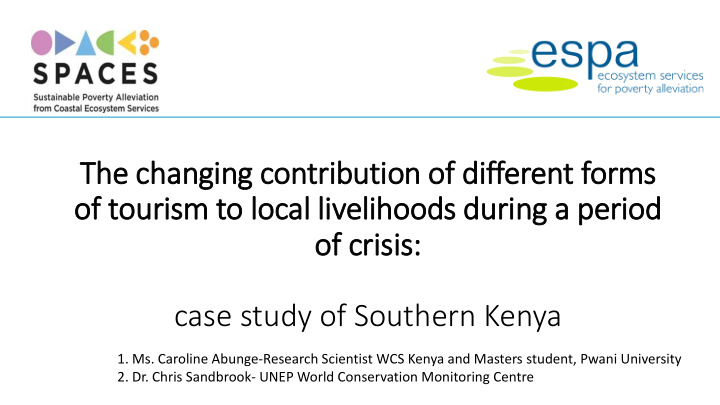



The changing contri ribution of different form rms of touri rism to local livelihoods d duri ring a peri riod of of crisis sis: case study of Southern Kenya 1. Ms. Caroline Abunge-Research Scientist WCS Kenya and Masters student, Pwani University 2. Dr. Chris Sandbrook- UNEP World Conservation Monitoring Centre
INTRODUCTION • Tourism is widely used as a tool to deliver poverty reduction from natural ecosystems • But: often criticized for being a volatile industry that can collapse • Few studies have looked at how such a collapse affects local livelihoods, wellbeing and resource use. • Tourism sector is one of the most important income earner in Kenya after agriculture. • 2014, Kenya experienced tourism slump in terms of reduction international arrivals, triggered by terrorist attacks and subsequent travel advisories • Affected the study area for Sustainable Poverty Alleviation from Coastal Ecosystem Services (SPACES) project – created new research opportunity
RESEARCH QUESTIONS How it makes people’s lives better State of Ecosystems Well-being Ecosystems W ES B 1. What are the impacts of the tourism slump on local livelihoods and wellbeing? 2. What were the local coping strategies that were adopted? 3. How do these new strategies impact natural resource use? • Note: These are preliminary results
• Focused on Vanga and Mkwiro STUDY AREA • Mkwiro heavily involved in tourism • Mostly snorkeling in KWS controlled marine park • Vanga control site with no tourism Vanga Mkwiro Tourism site
Site Characteristics X Tourism is the 3 rd important occupation in Mkwiro.
METHODS • Tourist visitor data • Kenya Wildlife Service records of visitor numbers • Household survey • Baseline household survey before the tourism slump in 2012 • Repeat survey of 140 households after tourism slump 2014
Ov Overal all tour urist nu numbers s in n de decline 2010 2010-201 2015 • There has been a clear decline in peak season visitor numbers over the last few years (blue arrow) ? • Particularly in 2014 • Things are perhaps recovering now? (green arrow) • Similar pattern in low season (June)
Per erceptio ion on on d dec eclin line an and e effec ect on on t tou ouris ism sec sector 100 Mkwiro 80 60 % Respondents 40 20 0 Same More Less Q. Are there more or less tourists compared to before April 2014 Overall reduction was less than 20% all sectors within the tourism sector affected. The mean reported decline was 55% over the last two years Over 62% indicated that there was a decrease in numbers of tourism and tourism activities. Tourism business type ??
Different pattern rns by vi visitor r nationality • International tourist numbers have gone down a lot • BUT: Kenyan citizen numbers have actually gone up
How it What is What people State of What it’s makes people’s Who produced get Ecosystems worth lives better benefits by nature from nature Goods Share Ecosystems Flows Value Well-being Daw et al 2016
What changed what activities undertaken for the last 12 months, which of those have 100 stopped and which were started. Stopped 90 Started Activities Lack of Lack of Low Grand 80 stopped Health Others materials time returns Age Hazards Tourism Total Trading 4 9 2 2 3 4 1 25 70 Farming 8 2 1 2 2 6 21 60 Fishing 4 0 2 1 1 8 Food 50 business 3 0 1 1 1 6 40 Gleaning 1 1 1 2 1 6 Salaried job 0 2 2 30 Tourism 2 2 20 Transport 1 1 2 Grand Total 20 15 8 7 7 6 6 4 73 10 0 New activities Others Supliment Survival Tourism decline Grand Total Mkwiro Vanga Trading 4 2 2 1 9 Most activities started were those that stopped • Food business 3 5 1 9 Despite the slump, not many stopped tourism • activities Fishing 3 1 2 6 fewer activities started compared to those Small business 0 1 2 1 4 • stopped Remittance 0 1 1 What is the connection between the slump and • Gleaning 0 1 1 farming and fishing? Grand Total 10 9 8 4 31
What d does all this mean? • Tourism has suffered in the area due to the terrorism crisis • Kenyan citizens have continued to visit the area – they are not put off – may be more resilient but also have lower impact as they spend little? • Coping strategy is low-the number and type of occupations started were lower than those stopped.
Key message • Although the relationship and connection of ES to WB is complex, it is evidence that ES supports livelihoods of the poor? • Intermediate factors for to be considered in the use of ES to alleviate poverty-its not a left right process and vice versa?
ASANTENI SANA
Recommend
More recommend